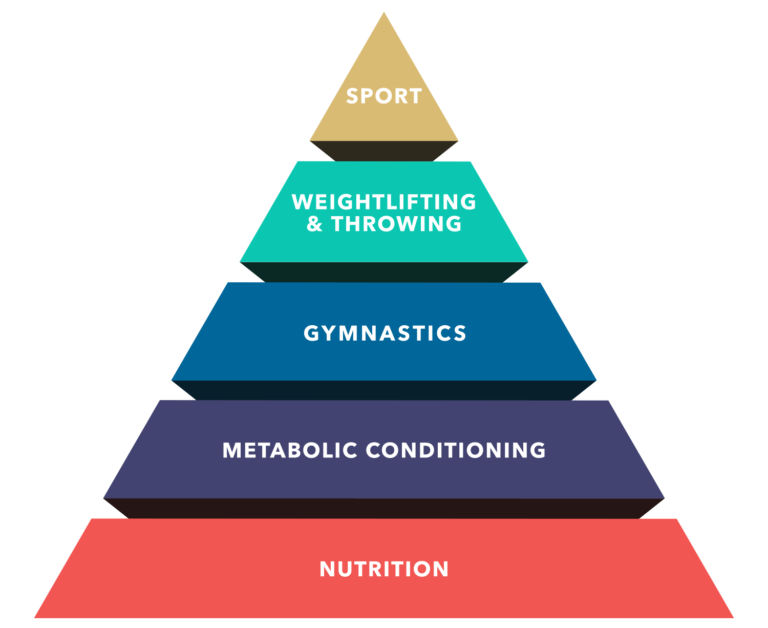 CrossFit’s Theoretical Hierarchy of the Development of an Athlete was first introduced in “What Is Fitness?” in 2002. This hierarchy underscores the foundational role of nutrition in enhancing health and performance. Sound nutrition is the foundation of health and performance because the food we consume acts as the vital fuel for all our activities. Unhealthy eating habits invariably lead to suboptimal performance and well-being. Conversely, making the right dietary choices in appropriate proportions can profoundly improve both our physical state and performance levels.
CrossFit’s Theoretical Hierarchy of the Development of an Athlete was first introduced in “What Is Fitness?” in 2002. This hierarchy underscores the foundational role of nutrition in enhancing health and performance. Sound nutrition is the foundation of health and performance because the food we consume acts as the vital fuel for all our activities. Unhealthy eating habits invariably lead to suboptimal performance and well-being. Conversely, making the right dietary choices in appropriate proportions can profoundly improve both our physical state and performance levels.
A prevalent misconception is that overhauling your nutrition must occur all at once, which can be mentally overwhelming and deter behavior change. In reality, these changes can be accomplished incrementally. Even a simple shift in breakfast choices — opting for eggs, fruit, and avocado over cereal — yields tangible health and performance improvements. These ongoing, gradual adjustments have a cumulative, transformative impact on your overall quality of life.
CrossFit’s Nutrition Prescription
CrossFit simplifies the concept of nutrition. Our recommendation is straightforward: Prioritize the consumption of meats, vegetables, nuts and seeds, some fruit, little starch, and no added sugar. To optimize your health and performance, keep intake to levels that support exercise and not body fat. Essentially, it boils down to adopting a diet rich in whole, unprocessed foods while minimizing sugar as much as possible.
Achieving this recommendation might appear uncomplicated in theory but can be challenging to implement, especially with an abrupt shift. For optimal outcomes, establish manageable habits that can be swiftly integrated, sustained, and compounded over time.
Quality Foods
The foundation of a healthy diet revolves around the transformation of dietary choices, shifting away from processed foods, and embracing whole, unadulterated alternatives. This forms the initial pillar of CrossFit’s dietary guidelines. To embark on this journey, it’s crucial to grasp the concept of processed foods and their exceptions. We champion the consumption of unprocessed or minimally processed foods, recognizing that certain food preparation methods — like cooking, chopping, heating, blending, preserving, or fermenting — are entirely acceptable.
For a clearer understanding of processed foods, it’s helpful to distinguish what they are not. High-quality food comprises unprocessed or minimally processed options that:
- Do not compromise our insulin response.
- Retain their nutrient value without degradation.
- Exclude extraneous ingredients like sugars, industrial seed oils, preservatives, artificial colorings, or other additives.
 Whole, natural foods can be categorized based on their predominant macronutrient content, even though they often contain a blend of macronutrients. Proteins, fats, and carbohydrates constitute these macronutrients, each playing vital roles in physiological processes such as energy generation, hormone synthesis, micronutrient absorption, and cellular growth, maintenance, and repair. The primary macronutrient composition of our recommended foods is outlined below.
Whole, natural foods can be categorized based on their predominant macronutrient content, even though they often contain a blend of macronutrients. Proteins, fats, and carbohydrates constitute these macronutrients, each playing vital roles in physiological processes such as energy generation, hormone synthesis, micronutrient absorption, and cellular growth, maintenance, and repair. The primary macronutrient composition of our recommended foods is outlined below.
Meat encompasses a wide range of protein sources, including animal proteins like beef, poultry, pork, and seafood, as well as alternatives such as tofu, tempeh, legumes, and eggs. Besides meeting your protein needs, these options deliver a rich array of essential vitamins and minerals. Notably, many animal proteins come with varying fat content, whereas non-animal sources may introduce carbohydrates into your diet. This diversity should be considered when planning your meals.
Vegetables denote an array of plants like leafy greens, carrots, peppers, and more. While they fall under the carbohydrate category, their digestible carb content is relatively low. Instead, vegetables shine as excellent sources of fiber, essential vitamins, minerals, and occasionally protein.
Nuts and seeds serve as the primary source of healthy fats. This category includes almonds, walnuts, coconuts, avocados, and oils like olive oil and avocado oil. These fats bring forth a range of vital nutrients. Though nuts and seeds do contain some protein and carbohydrates, their main contribution lies in the substantial healthy fats they offer. Please note that vegetable oils are not included due to their potential adverse effects on health.
Some fruit means fruits with moderate carbohydrate content, such as apples, berries, bananas, and melons. Beyond sugars like glucose and fructose, fruits bring fiber, vitamins, minerals, and even a modest protein content. The term “some” underscores the importance of moderating your carbohydrate intake.
Little starch addresses carbohydrate sources with high digestibility, typically found in grains like wheat, rice, and potatoes, as well as legumes. These foods contain moderate levels of vitamins, minerals, and a limited protein content, all at lower densities compared to other categories. The word “little” emphasizes the need for moderation in your carbohydrate consumption.
No sugar unequivocally excludes all forms of added sugars, including natural sweeteners like honey or maple syrup and artificial sweeteners like sucralose. Whole foods contain naturally occurring sugars and so it’s important to note that this guideline refers to added sugars. This strict parameter promotes optimal gut health and hormonal balance.
Why No Sugar?
Excess sugar consumption has been linked to conditions such as insulin resistance, hyperinsulinemia, and a host of chronic diseases such as cardiovascular disease and Type 2 diabetes. Sugar comes in the form of many names in order to hide the ingredient in the ingredient list. Examples include agave nectar, barley malt, evaporated cane juice, carob syrup, corn syrup solids, dextrin, fruit-juice concentrate, maltodextrin, rice syrup, and sweet sorghum, to name a few.
A lot of processed foods are now replacing sugar with artificial sweeteners, which seems, on the surface, like a good idea to reduce the risk of metabolic disease. This may seem like a good strategy, but most of these foods still include industrialized seed oils, and recent research indicates non-caloric sweeteners may impact our metabolism — directly or indirectly. Sucralose and acesulfame potassium can raise insulin levels directly, while sweeteners like aspartame may negatively alter gut bacteria, potentially increasing insulin resistance. Artificial sweeteners, being highly processed chemicals, don’t align with a whole, unprocessed food diet.
Even “natural” sweeteners like stevia have their drawbacks. Emerging research links stevia to potential disruptions in gut health, possibly leading to issues such as irritable bowel syndrome, which is associated with metabolic disorders like obesity and Type 2 diabetes.
What is an industrialized seed oil?
When prioritizing wellness through dietary choices, it’s crucial to steer clear of not only added sugars but also industrialized seed oils. Typically found as additives in processed foods, these oils include canola, corn, cottonseed, soy, sunflower, safflower, and grapeseed oils. Despite their reputation as heart-healthy options, industrialized seed oils come with notable health concerns. They are high in omega-6 fatty acids, which can disrupt the omega-6 to omega-3 balance in the body. While both fats play vital roles in human health, an imbalanced ratio can promote excessive inflammation. Because these oils are so prevalent in our food supply, an imbalance occurs and chronic inflammation ensues.
Simply, omega-6 fatty acids tend to be pro-inflammatory, while omega-3 fatty acids are anti-inflammatory. Some inflammation is essential for normal bodily functions, such as recovery from exercise or illness. However, chronic inflammation, characterized by sustained, low-level inflammation, can be detrimental. It can overstimulate the immune system, leading to attacks on healthy tissues and organs. Chronic inflammation is linked to serious conditions like cardiovascular disease, cancer, Type 2 diabetes, arthritis, and digestive disorders.
Healthy alternatives to these industrialized seed oils are healthier oils such as olive oil, coconut oil, avocado oil, or fats such as butter and lard. At first glance, the words “fats,” “butter,” and “lard” may create a sense of panic. For years, we have been told these saturated fats have a detrimental effect on our heart health. This theory has been debunked over and over again, but the misconception has remained common in the mainstream. The real risk with saturated fats is when they are eaten in conjunction with high amounts of sugar, a combination common in processed foods.
Measuring Intake
The second facet of the CrossFit nutrition recommendation revolves around precise portion control. CrossFit recommends maintaining intake at levels that support exercise and not body fat, and emphasizes the importance of measuring our food intake to meet the energy requirements of our daily lives, workouts, and recovery. Consuming more can lead to unwanted fat storage, while significantly less can result in health issues like nutritional deficiencies, muscle loss, slowed metabolism, fatigue, hormonal imbalances, weakened immunity, cognitive impairments, reduced bone density, and long-term sustainability concerns.
There are myriad options when it comes to measuring food intake, and it’s important to find what works best for you. Many in the CrossFit community utilize a block-based system known as the Zone Diet, featuring a 40% carbohydrate, 30% protein, and 30% fat ratio. Athletes determine their starting point through a straightforward calculation and adjust over time to align with their health and performance objectives.
As technology has advanced, smartphone apps have gained popularity, enabling a macro-counting approach, known as Macros. In this method, athletes establish a baseline, typically following the 40% carb, 30% protein, and 30% fat guideline. Instead of tracking blocks as one does on the Zone Diet, athletes monitor gram intake to meet their specific macronutrient targets, allowing for personalized adjustments as they progress.

Quantity of food will depend on each individual’s lifestyle, phase of life, and activity levels. When quantifying food intake, CrossFit recommends eating three to five meals within a 12-hour window. That means if you wake up at 6 a.m. and start eating at 7 a.m., you would consume all your food before 7 p.m. that same day.
This approach reduces the body’s need to burn sugar as fuel, leading to improved insulin sensitivity and reduced risk of insulin resistance. Limiting your eating time to a 12-hour window also ensures a steady caloric intake throughout the day, which plays a crucial role in maintaining consistent energy levels. Additionally, it aids in increasing satiety and minimizing cravings, preventing the pitfalls of both undereating and overeating. Finally, this method provides an accessible and sustainable starting point. It allows you to fine-tune your dietary choices over time, learning what works best for you and making necessary adjustments to align with your individual needs and goals.
The CrossFit Nutrition I online course offers a streamlined method for determining your macronutrient requirements.

 Michael Giardina started CrossFit in 2005. He has worked as a trainer at a CrossFit affiliate and as a CrossFit Seminar Staff Flowmaster and Content Supervisor. He has competed at the CrossFit Games and served as a CrossFit Games Head Judge. He is a Certified CrossFit Coach (CF-L4), has a Master of Science in exercise physiology, a Master of Public Health degree, and works as CrossFit’s Senior Manager of Health Education.
Michael Giardina started CrossFit in 2005. He has worked as a trainer at a CrossFit affiliate and as a CrossFit Seminar Staff Flowmaster and Content Supervisor. He has competed at the CrossFit Games and served as a CrossFit Games Head Judge. He is a Certified CrossFit Coach (CF-L4), has a Master of Science in exercise physiology, a Master of Public Health degree, and works as CrossFit’s Senior Manager of Health Education.